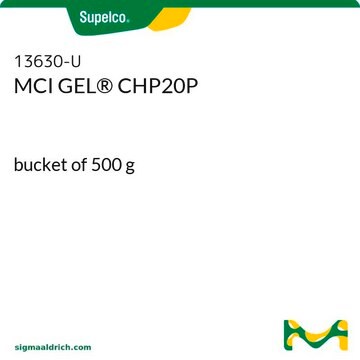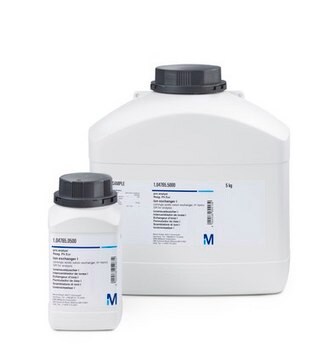13615-U
Diaion® HP-20SS polymeric adsorbent
100-230 mesh, bucket of 1000 g
Synonym(s):
carbon adsorbent, CMS, 20-45 mesh
Sign Into View Organizational & Contract Pricing
All Photos(1)
About This Item
UNSPSC Code:
23151817
NACRES:
SB.52
Recommended Products
Product Name
Diaion® HP-20SS, bucket of 1000 g
form
liquid
packaging
bucket of 1000 g
technique(s)
LPLC: suitable
surface area
~500 m2/g
matrix
styrene-divinylbenzene
matrix active group
polymer
particle size
75-150 μm
pore size
~1.30 mL/g pore volume
260 Å mean pore size
density
1.01 g/mL at 25 °C (true wet)(lit.)
separation technique
reversed phase
Looking for similar products? Visit Product Comparison Guide
Related Categories
Application
Polyaromatic adsorbent for the separation of hydrophobic compounds and biomolecules from fermentation broths. this resin provides rapid kinetics for large molecules, works well in nonaqueous applications, and can be used for scale-up industrial fractionation of small biomolecules.
Other Notes
Swelling in toluene = 30%
Legal Information
Diaion is a registered trademark of Mitsubishi Chemical Corp.
Storage Class Code
10 - Combustible liquids
WGK
WGK 3
Flash Point(F)
Not applicable
Flash Point(C)
Not applicable
Choose from one of the most recent versions:
Already Own This Product?
Find documentation for the products that you have recently purchased in the Document Library.
Tim S Bugni et al.
Molecules (Basel, Switzerland), 13(6), 1372-1383 (2008-07-04)
The high-throughput screening and drug discovery paradigm has necessitated a change in preparation of natural product samples for screening programs. In an attempt to improve the quality of marine natural products samples for screening, several fractionation strategies were investigated. The
Jinhee Kim et al.
Food & function, 4(2), 258-265 (2012-11-03)
Lemons are a widely used citrus crop and have shown several potential health benefits. In the present study, the mechanism and effectiveness of the anti-cancer and anti-aromatase properties of limonoids were investigated for the first time. Defatted lemon (Citrus lemon
Kellie L Tuck et al.
Organic & biomolecular chemistry, 4(19), 3598-3610 (2006-09-23)
Pantothenate synthetase catalyses the ATP-dependent condensation of D-pantoate and beta-alanine to form pantothenate. Ten analogues of the reaction intermediate pantoyl adenylate, in which the phosphodiester is replaced by either an ester or sulfamoyl group, were designed as potential inhibitors of
Our team of scientists has experience in all areas of research including Life Science, Material Science, Chemical Synthesis, Chromatography, Analytical and many others.
Contact Technical Service







